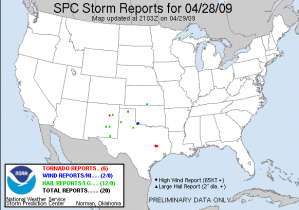 |
Archive for the ‘Disaster Incidents & Hazardous Weather Outlook’ Category
Thursday, April 30th, 2009
At last week’s Hospital Librarians Summit, it was suggested that we link to a site that would show reports of weather-related events. As a result, we now have a link to NOAA’s Storm Prediction Center’s report of the previous day’s storms. The link (Yesterday’s Storm Reports) is located on the right column of the Toolkit under the category Alerts and Reports.

Posted in Disaster Incidents & Hazardous Weather Outlook, Hazardous Weather, Severe Storm, Tornadoes | No Comments »
Wednesday, April 15th, 2009
It’s good to be “on the same page” with an organization like Heritage Preservation! Check out their “Do One Thing” initiative for May Day (May 1) this year. They encourage all libraries and cultural institutions to take some of the same actions the NN/LM is recommending to its members in its “10-Step Approach to Service Continuity,” such as prioritizing collections for rescue, establishing relationships with “buddy” institutions, etc. They also mention that their Disaster Wheel and accompanying Field Guide are on sale at a special price for May Day. These materials have been highly recommended to NN/LM members throughout the training sessions in emergency preparedness and response that have been offered over the past year and a half.
The Heritage site also notes that even though hurricane “season” doesn’t start until June 1, our continent is already experiencing severe weather and flooding, noting that a disaster can happen at any time and in any place. If you visit their site, you might enjoy looking around a bit while you are there. Heritage Preservation (a partner with FEMA) is an excellent resource for all things preservation and recovery for collections. Where the NN/LM emergency preparedness initiative complements Heritage is its focus on service continuity to patrons in terms of providing health related information.

Posted in Disaster Incidents & Hazardous Weather Outlook, Featured Web Site, Flooding, Suggested Readings | No Comments »
Tuesday, March 3rd, 2009
As winter bids us farewell with a few inches of snow and sub-freezing temperatures (increasingly rare here in central Virginia), we note that the likelihood of tornadoes will be increasing as the weather turns warmer. As they say, there is no real tornado “season,” because one can happen any time and in any place, but we see that internet searchers are looking for information on tornado preparedness more often now, so here is some information that we hope will be helpful in preparing for the tumultuous spring weather than can give birth to tornadoes and other severe storms.
As always, the Centers for Disease Control & Prevention web site offers excellent information and advice on tornadoes as part of their Emergency Preparedness and Response information, specifically their Natural Disasters and Severe Weather page. Click on the “Tornado” link for some great information on what you should know and what to do before a tornado, during and afterwards. For instance, what do you think is the most dangerous aspect of a tornado? Where is the most dangerous place to be in a tornado? The answers may surprise you!
Many states will be running tornado preparedness drills in March. Here’s the Virginia site that lists information about the state-wide drill on March 17, as well as how to run a tornado drill. Check out the information on the page about how to find the safest place inside your building to shelter from a tornado.
NOAA weather radios are wonderful to have in your building if you are in an area that is particularly vulnerable to servere storms, or you just want to keep in touch with weather events. They are available with a range of features and at a price range from $25 and up, from a variety of sources. (Amazon lists many models and prices.) Ours has alerted us several times to thunderstorms in the summer, which helped us to be prepared for possible power disruptions and wind/water damage. The NOAA radios receive information continuously from the National Weather Service, and you can set them to sound an alert to your specific area so that the alarm doesn’t sound more often than necessary. Best wishes to everyone for a safe and happy spring season!

Posted in Alerting Systems, CDC, Disaster Incidents & Hazardous Weather Outlook, Drills, Featured Web Site, Hazardous Weather, Severe Storm, Shelter in Place, Suggested Readings, Tornadoes, and Hazardous Weather Outlook | No Comments »
Tuesday, December 30th, 2008
The Centers for Disease Control and Prevention have an excellent web site with a wealth of health and safety-related information on a broad range of topics and for many audience types. They have redesigned and reorganized, including more images, and the navigation features lend themselves well to helping users find information quickly. We can benefit particularly from their Emergency Preparedness and Response pages, and today are focusing on their Natural Disasters and Severe Weather subsite. For each event, they have gathered excellent information, some of which they have written, and some that links to other, related sites. Check out the “Earthquake” page, which warns that between 2008 and 2035, seismologists predict a 97 percent chance of a major quake in the New Madrid seismic zone (central US: Tennessee, Kentucky, Arkansas, Missouri).

Posted in Disaster Incidents & Hazardous Weather Outlook, Featured Web Site, Preparedness | No Comments »
Tuesday, January 15th, 2008
Ready.gov is making available a wealth of information about preparation for and strategies for dealing with winter weather. They have instructions about what to do if you’re trapped in your car during a blizzard, how to recognize and begin treatment for hypothermia, a list of supplies to have on hand at home “just in case.” Winter storms are called “deceptive killers” because it is their side-effects, the peripheral damage, such as power outages and traffic accidents that cause the most deaths. The info is helpful to know even if you don’t live in a winter-weather prone area; it might come in handy if you’re travelling, plus power-outages happen everywhere and any time!
Posted in Disaster Incidents & Hazardous Weather Outlook, Featured Web Site, Hazardous Weather, Preparedness, Severe Storm | No Comments »
Tuesday, January 15th, 2008
Ready.gov is making available a wealth of information about preparation for and strategies for dealing with winter weather. They have instructions about what to do if you’re trapped in your car during a blizzard, how to recognize and begin treatment for hypothermia, a list of supplies to have on hand at home “just in case.” Winter storms are called “deceptive killers” because it is their side-effects, the peripheral damage, such as power outages and traffic accidents that cause the most deaths. The info is helpful to know even if you don’t live in a winter-weather prone area; it might come in handy if you’re travelling, plus power-outages happen everywhere and any time!
Posted in Disaster Incidents & Hazardous Weather Outlook, Featured Web Site, Hazardous Weather, Preparedness, Severe Storm | No Comments »
Tuesday, January 8th, 2008
Microsoft has released a new software and services platform, HealthVault, to help people store and manage their health information online, as well as search for health information. This looks like an excellent resource for use by people in disaster-prone areas, such as hurricane and tornado alleys. Keeping health-related records “off-site” through a service such as HealthVault would enable people who are suddenly displaced to retrieve information about prescriptions, medical records, etc. from anywhere. We know, from the lessons learned courtesy of hurricanes Katrina and Rita, that many people who were forced to evacuate were not able to remember the names of their medications in many cases, recalling only the color and the number of pills they usually took.
Could promoting this be a role for librarians, especially in hospital settings?
Posted in Computers/Networks, Core Resources, Disaster Incidents & Hazardous Weather Outlook, Disaster Planning, Featured Web Site, Preparedness | No Comments »
Friday, July 27th, 2007
‘Tis the season in the South!…..thunderstorms with torrential rains and strong winds, hot, muggy days that make air conditioning systems work overtime…all contribute to increased risk for leaking roofs, doorways, windows, and pipes and for flooding from blocked drains, construction sites, etc. Here are a few suggestions for catching these situations before they become catastrophes:
- conduct a daily inspection of any areas where water has come in before. Any stained ceiling tiles? Any musty smell? Any condensation build-up on exposed pipes or ductwork?
- keep an eye on the weather forecast
- ask your Facilities maintenance people to check outside drains to make sure they are clear of debris
- if you don’t know already, find out what kinds of rooms are on the floors above your space (if any) and whether they pose a threat of leaking water into your space
- replenish any disaster supplies that might be needed, such as paper towelling, rubber gloves, masks, buckets/mops
- if you don’t already have any absorbent “socks” for soaking up water off the floor, order them! (a site: New Pig)
- make sure you have current phone numbers for your response team and for the Facilities people at your institution
- know how much you can do yourself, and whom to call for back-up (commercial salvage companies, conservation organizations, etc.)
- here’s a helpful regional resource from the CCAHA listing companies that provide all sorts of materials for salvage and preservation activities: Mid-Atlantic Resource Guide for Disaster Preparedness
Posted in Disaster Incidents & Hazardous Weather Outlook, Flooding, Hazardous Weather, Preparedness, Severe Storm | No Comments »
Friday, July 27th, 2007
‘Tis the season in the South!…..thunderstorms with torrential rains and strong winds, hot, muggy days that make air conditioning systems work overtime…all contribute to increased risk for leaking roofs, doorways, windows, and pipes and for flooding from blocked drains, construction sites, etc. Here are a few suggestions for catching these situations before they become catastrophes:
- conduct a daily inspection of any areas where water has come in before. Any stained ceiling tiles? Any musty smell? Any condensation build-up on exposed pipes or ductwork?
- keep an eye on the weather forecast
- ask your Facilities maintenance people to check outside drains to make sure they are clear of debris
- if you don’t know already, find out what kinds of rooms are on the floors above your space (if any) and whether they pose a threat of leaking water into your space
- replenish any disaster supplies that might be needed, such as paper towelling, rubber gloves, masks, buckets/mops
- if you don’t already have any absorbent “socks” for soaking up water off the floor, order them! (a site: New Pig)
- make sure you have current phone numbers for your response team and for the Facilities people at your institution
- know how much you can do yourself, and whom to call for back-up (commercial salvage companies, conservation organizations, etc.)
- here’s a helpful regional resource from the CCAHA listing companies that provide all sorts of materials for salvage and preservation activities: Mid-Atlantic Resource Guide for Disaster Preparedness
Posted in Disaster Incidents & Hazardous Weather Outlook, Flooding, Hazardous Weather, Preparedness, Severe Storm | No Comments »
|
 |









